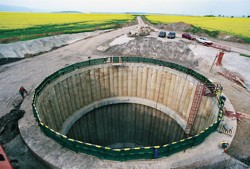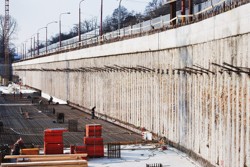 Pile walls stand for one of the most commonly used constructions of permanent sheeting and construction walls carried out with methods of special foundation engineering. Pile walls normally consist of driven piles of a uniform diameter (d) carried out in line, and they can be divided according to the axial distance between piles (a) into:
Pile walls stand for one of the most commonly used constructions of permanent sheeting and construction walls carried out with methods of special foundation engineering. Pile walls normally consist of driven piles of a uniform diameter (d) carried out in line, and they can be divided according to the axial distance between piles (a) into:
» free-standing pile walls, with a > d,
» tangential pile walls, with a = d,
» secant pile walls, with a < d.
Free-standing pile walls are mainly used as permanent constructional units that create framing walls, protect half-cuts and cuts of communications, or create permanent vertical walls of buildings. They cannot be designed as waterproof. According to their free height they are normally anchored at single or multiple levels, normally over pre-set reinforced concrete strap anchors. The space between individual piles is usually dewatered in an appropriate way and provided with a permanent construction- most commonly with shotcrete with a reinforcement mesh that can be architecturally shaped (into vaults, flat surfaces,etc.). Walls constructed in this way are normally face ones, in special cases they are fitted with suspended elevational panels.

Examples of pile walls types
1a) free-standing - shotcrete with a reinforcement mesh
1b) tangential
1c) secant

 Tangential pile walls are designed less often than free standing pile walls. They make up extremely loaded permanent constructions when it is not possible for static reasons to place piles in bigger axial distances. In these cases it is, however, possible to place anchors suitably between pairs of piles so that it was not necessary to project pre-set strap anchors. Tangential pile walls cannot be considered as water proof either, even though they can be dewatered appropriately and provided with a sprayed concrete surface.
Tangential pile walls are designed less often than free standing pile walls. They make up extremely loaded permanent constructions when it is not possible for static reasons to place piles in bigger axial distances. In these cases it is, however, possible to place anchors suitably between pairs of piles so that it was not necessary to project pre-set strap anchors. Tangential pile walls cannot be considered as water proof either, even though they can be dewatered appropriately and provided with a sprayed concrete surface.
Secant pile walls are a commonly used type of pile walls as they replace diaphragm monolithic walls in cases where it is not possible, for various reasons, to use slurry casing. First of all, a specific number of so called primary piles are carried out from plain concrete and after the concrete partly hardens secondary piles are carried out in between them. In the process of drilling secondary piles, a part of primary piles is re-drilled resulting in constructional connection of both types of piles. Secondary piles are reinforced with reinforcement cages. If it is necessary to anchor a pile wall, primary piles are used favourably for this purpose. Realisation of secant pile walls requires setting up of quality guiding templates as well as application of high-performance drilling sets that are able to keep the verticality of holes. Secant pile walls are also designed as water proof constructions. If they make up walls of basements of buildings, they are provided with a shotcrete layer.